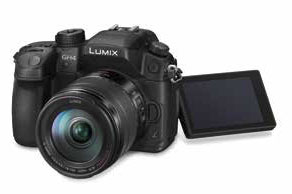articles/Cameras/which-compact-system-camera-page4
You've got to have a system - part 4 of 1 2 3 4 5 6 7
Published 10/04/2015

Panasonic Lumix DMC-GH4
At the core of the range-topping GH4 from Panasonic, which, lest we forget, introduced the first ever CSC back in late 2008, is a 17.20-megapixel 17.3x13.0mm CMOS sensor, providing a 16.05 effective megapixel resolution. But arguably the main selling point here is that 8.8 megapixel stills can be extracted from 4K video, simply by using the rear panel touch-screen to tab through footage frame-by-frame and then make your saved selection. Potentially laborious if you have hours of footage shot at a wedding to sift through, but as an indication of the shape of things to come, this facility excites us. Until Sony announced its A7S camera a couple of weeks afterwards, followed by the Samsung NX1, it was the only interchangeable lens model offering 4K video capture, and it remains one of a select club. Panasonic has always pitched its 'GH' series of Lumix system cameras as 'hybrids', but for us the GH4 is the closest it has come to fully realising that boast. It offers a distinct advantage for anyone involved in photographing weddings or events, where a separate video might have at one time otherwise been commissioned.
The brand has also boasted long term about the swiftness and accuracy of its AF response, with this automatically adjusting for video as well as stills. But we also enjoyed the flexibility provided via 2.4 million-dot eye-level electronic viewfinder, plus, sitting beneath it, the impressively adjustable 1.036 million dot swivel and tilt monitor. Here there is a good degree of flexibility provided governing how the 3.0-inch screen is used; it can be flipped outwards from the body, as with a camcorder, and rotated to face the subject before the lens. It can also be flipped to face screen-inwards for added protection when transporting the camera. While we don't get body-integral image stabilisation, we do get reassuringly weighty splash and dust-proof construction.

Panasonic was one of the first to add NFC to its camera line up, and so we get that connectivity option here, along with 'regular' Wi-Fi. The only thing that might be seen on paper as an Achilles' heel is the fact that the GH4, as with the Olympus OM-D, incorporates a Four Thirds format sensor. As keen observers will be aware, this is physically smaller than the full-frame chip of the Sony A7S, and the regular APS-C format chip that could be found in a typical consumer DSLR for markedly cheaper than the £1,000+ being asked for the Panasonic. Still, in practice for anyone seeking to add the 'string' of video capture to their bow, it's a damn sight easier to film with the GH4 - and 4K video, at that - than via the standard DSLR it resembles. Slightly spoiling us, we had a 14-140mm Power Zoom to play with when we tested it, which provides a 35mm equivalent film range of double that; in other words a massively useful, all-encompassing 28-280mm. If you want this as well as the camera body, you were looking at circa £1,750 all in at the time of writing.
As this is a semi-pro model, there are plenty of user definable function buttons to exert control over, plus also a lever alongside the electronic viewfinder for switching focus mode between continuous AF, or single shot AF, the camera finding focus with the shutter release button partially depressed. Stills are flatteringly colourful yet not unrealistically so and sharp too, even at the extremity of the provided Power Zoom. The lens further enables attractive 'bokeh' effects. In terms of low light shooting without flash, again the camera excels, though stick between ISO1600 and 3200 if you want to avoid a gradually more painterly effect as image processing kicks in, with noise otherwise having reached its nadir by maximum ISO 25,600.
Ultimately the most natural market for the GH4 feels like serious amateurs and semi-pros, though one could argue that professionals will find the GH4 of use if they're sick of lugging around a much heavier and bulkier DSLR, and don't actually need billboard-sized pictures. While it's the priciest Panasonic you can buy, since there are only a couple of cameras with this capability at consumer prices, the outlay could be easier justified. And the beauty of a reliably performing camera like the GH4 is that one can be as hands on or hands off as desired. The same is true of the even newer and smaller format Panasonic GX7, a range topper in its own enthusiast series, but a CSC that, unlike the GH4, doesn't offer 4K capture.
Please Note:
There is more than one page for this Article.
You are currently on page 4
- You've got to have a system page 1
- You've got to have a system page 2
- You've got to have a system page 3
- You've got to have a system page 4
- You've got to have a system page 5
- You've got to have a system page 6
- You've got to have a system page 7
1st Published 10/04/2015
last update 09/12/2022 15:00:23
More Cameras Articles
There are 0 days to get ready for The Society of Photographers Convention and Trade Show at The Novotel London West, Hammersmith ...
which starts on Wednesday 15th January 2025





